Rapid7 InsightIDR
Overview
Rapid7's InsightIDR is your security center for incident detection and response, authentication monitoring, and endpoint visibility. InsightIDR identifies unauthorized access from external and internal threats and highlights suspicious activity so you don't have to weed through thousands of data streams.
D3 SOAR is providing REST operations to function with Rapid7 InsightIDR.
Rapid7 InsightIDR is available for use in:
Known Limitations
The total number of requests you are permitted to make in the rate limit window. The rate limit window is typically 15 or 60 minutes, but varies by API. Please refer to the Insight Platform API overview for more information.
Connection
To connect to Rapid7 InsightIDR from D3 SOAR, please follow this part to collect the required information below:
Parameter | Description | Example |
Server URL | The server URL of the Rapid7 InsightIDR API. | https://ca.api.insight.rapid7.com |
API Key | The API key to authenticate the connection. | *** |
API Version | The API version to use for the connection. | v1 |
Permission Requirements
Each endpoint in the Rapid7 InsightIDR API requires a certain permission scope. The InsightIDR Admin role is required for the commands in this integration.
As Rapid7 InsightIDR is using role-based access control (RBAC), the API access key is generated based on a specific user account and the application. Therefore, the command permissions are inherited from the user account’s role. Users need to configure their user profile from the Rapid7 InsightIDR console for each command in this integration.
Reader Note
Rapid7 InsightIDR’s default user profiles (sorted from the least permissions to the most) are as follows:
Log Search View Only
Log Search View and Change
Log Search Admin
InsightIDR Viewer
InsightIDR Analyst
InsightIDR Admin
Please refer to Manage Insight Platform users with role-based access control (RBAC) for more information.
Configuring Rapid7 InsightIDR to Work with D3 SOAR
Log in to Rapid7 InsightIDR with your credentials.
Click on the settings icon, and select Users.
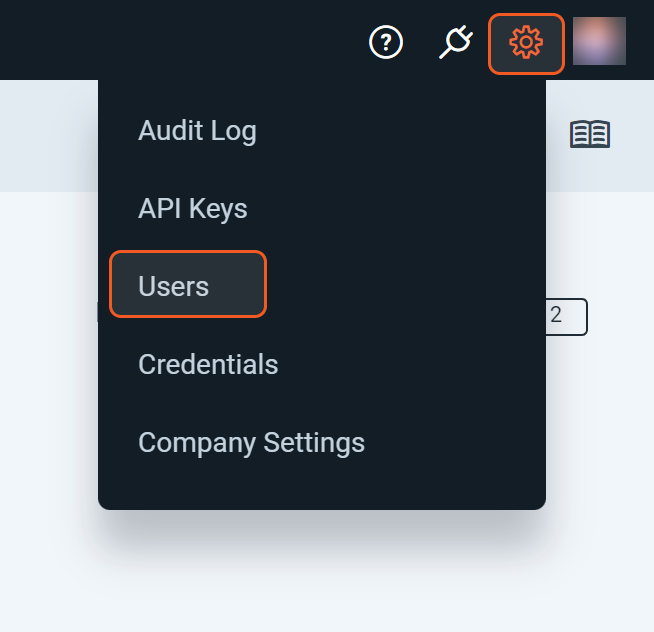
Add a user and assign the InsightIDR Admin role.
Log out of your current account and log back in using the newly created account.
Click on the settings icon, and select API Keys.
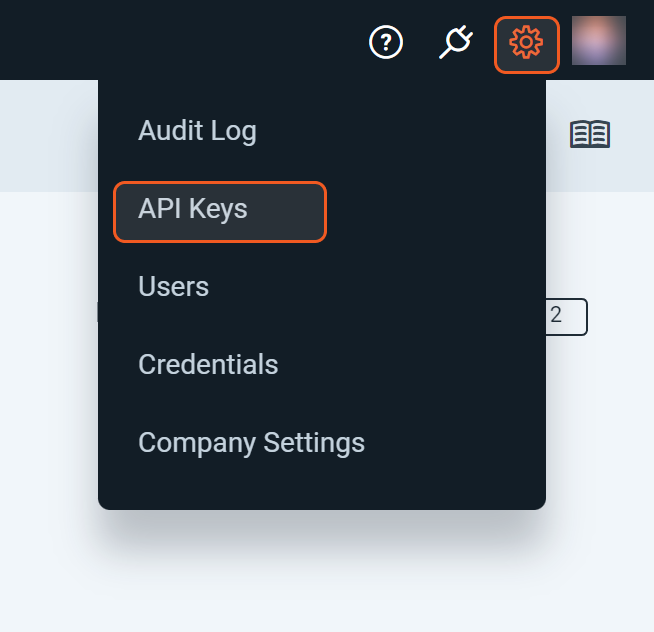
Click New User Key. You will notice a User column indicating which user generated the key. The permissions associated with that user will be inherited by the API key.
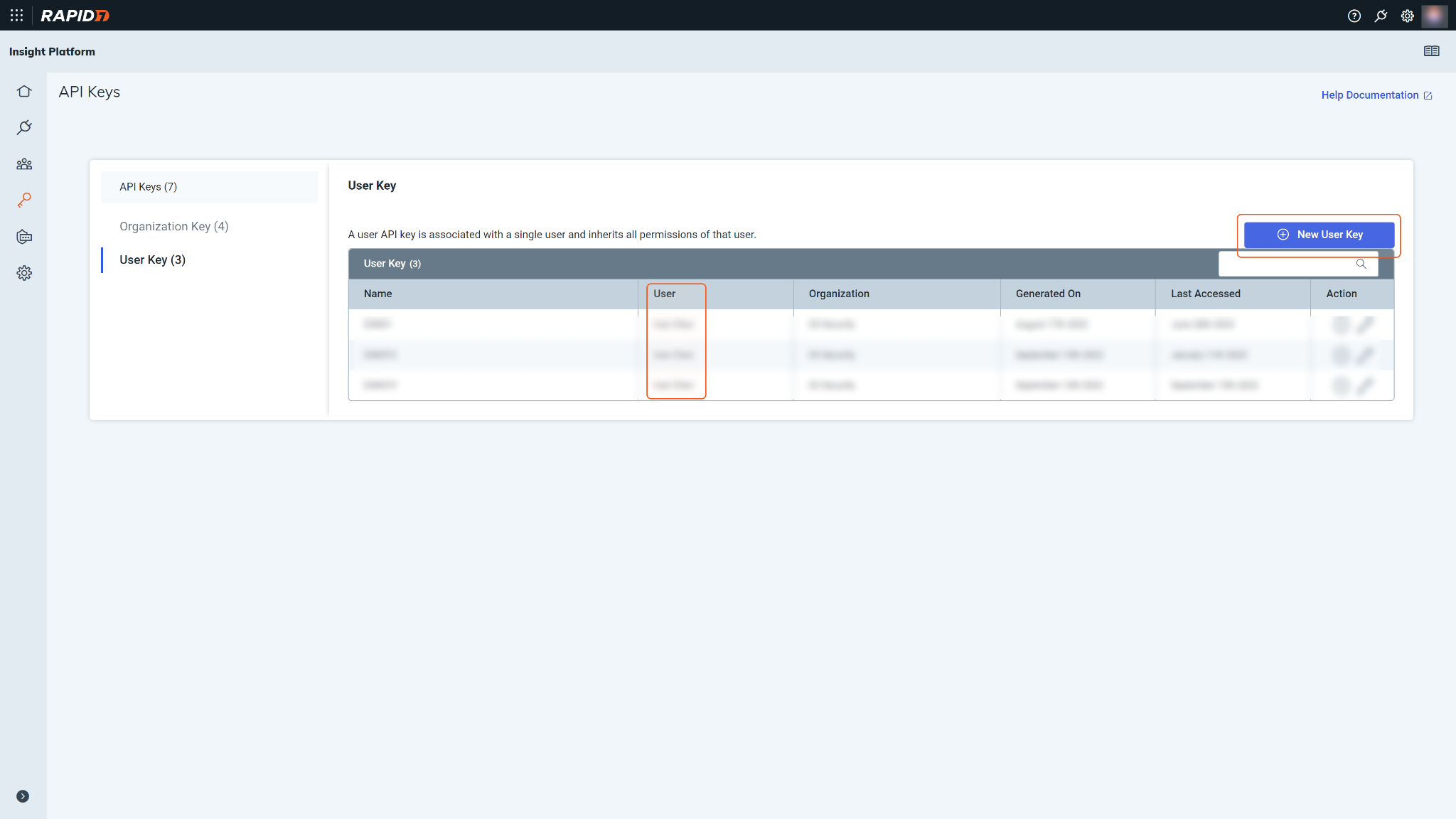
Provide a name for the API key and click Generate.
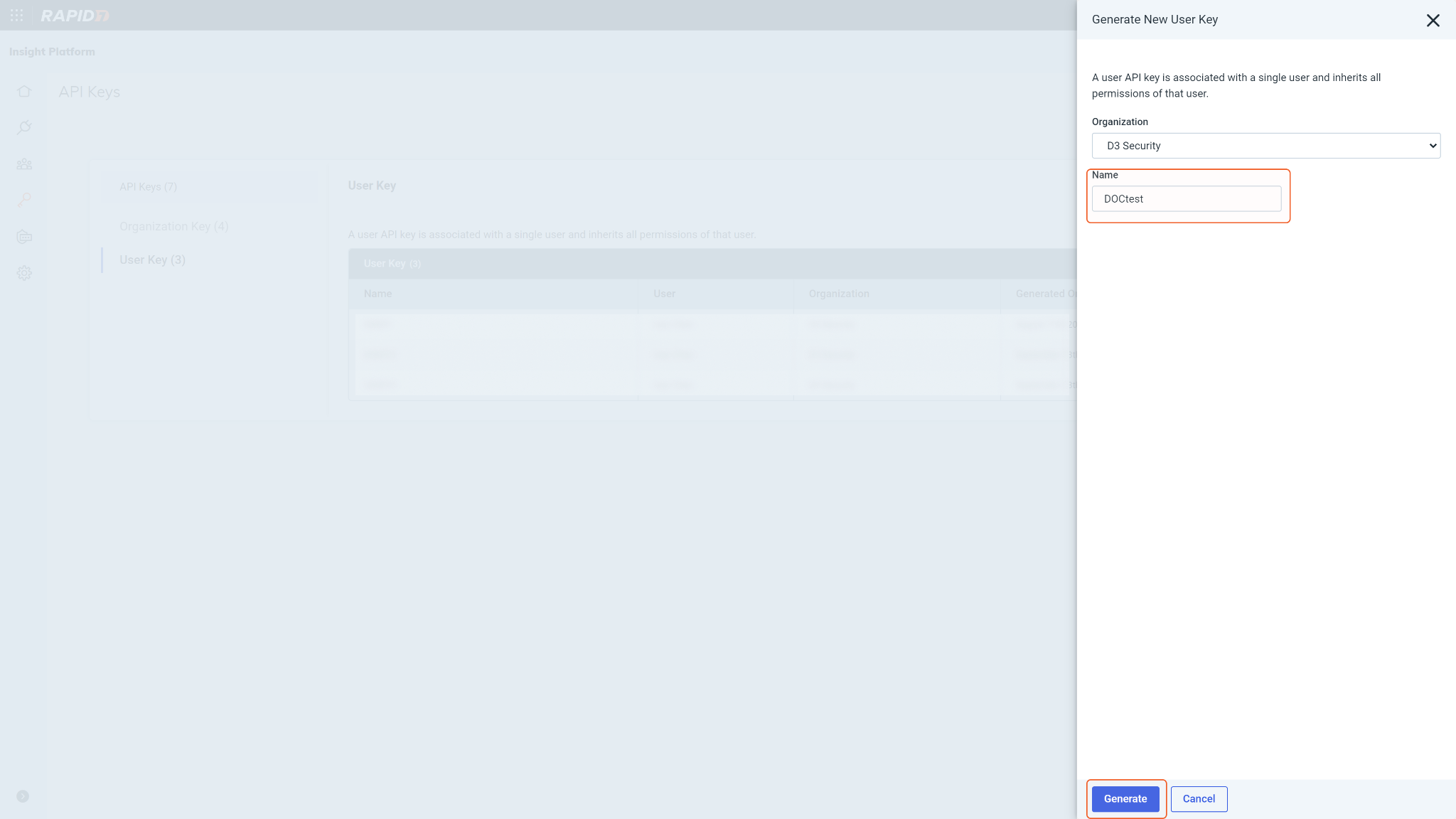
Make sure to save your API key in a secure location. This will be your only opportunity to view the key. If you happen to lose it, you will need to generate a new API key.
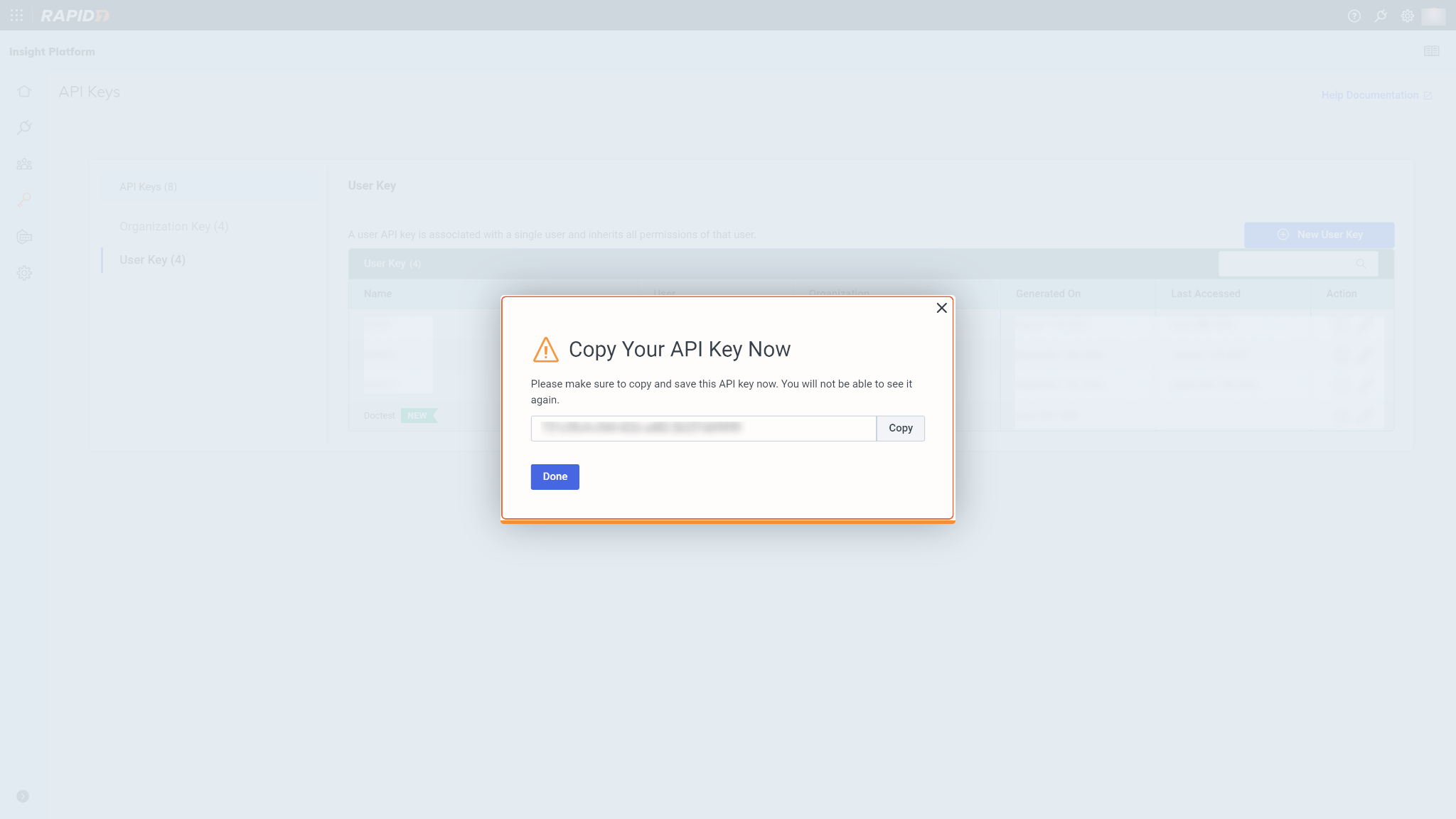
Configuring D3 SOAR to Work with Rapid7 InsightIDR
Log in to D3 SOAR.
Find the Rapid7 InsightIDR integration.
Navigate to Configuration on the top header menu.
Click on the Integration icon on the left sidebar.
Type Rapid7 InsightIDR in the search box to find the integration, then click it to select it.
Click + New Connection, on the right side of the Connections section. A new connection window will appear.
Configure the following fields to create a connection to Rapid7 InsightIDR.
Connection Name: The desired name for the connection.
Site: Specifies the site to use the integration connection. Use the drop-down menu to select the site. The Share to Internal Sites option enables all sites defined as internal sites to use the connection. Selecting a specific site will only enable that site to use the connection.
Recipient site for events from connections Shared to Internal Sites: This field appears if you selected Share to Internal Sites for Site to let you select the internal site to deploy the integration connection.
Agent Name (Optional): Specifies the proxy agent required to build the connection. Use the dropdown menu to select the proxy agent from a list of previously configured proxy agents.
Description (Optional): Add your desired description for the connection.
Tenant (Optional): When configuring the connection from a master tenant site, you have the option to choose the specific tenant sites you want to share the connection with. Once you enable this setting, you can filter and select the desired tenant sites from the dropdowns to share the connection.
Configure User Permissions: Defines which users have access to the connection.
Active: Check the tick box to ensure the connection is available for use.
System: This section contains the parameters defined specifically for the integration. These parameters must be configured to create the integration connection.
1. Input the Server URL. The default value is https://ca.api.insight.rapid7.com.2. Copy the API Key from the Rapid7 InsightIDR platform. Refer to the step 4 of Configuring Rapid7 InsightIDR to Work with D3 SOAR.
3. Input the API Version. The default value is v1.
Enable Password Vault: An optional feature that allows users to take the stored credentials from their own password vault. Please refer to the password vault connection guide if needed.
Test the connection.
Click Test Connection to verify the account credentials and network connection. If the Test Connection Passed alert window appears, the test connection is successful. You will see Passed with a green checkmark appear beside the Test Connection button. If the test connection fails, please check your connection parameters and try again.
Click OK to close the alert window.
Click + Add to create and add the configured connection.
Commands
Rapid7 InsightIDR includes the following executable commands for users to set up schedules or create playbook workflows. With the Test Command, you can execute these commands independently for playbook troubleshooting.
Integration API Note
For more information about the Rapid7 InsightIDR API, please refer to the Rapid7 InsightIDR API reference.
Reader Note
Certain permissions are required for each command. Please refer to the Permission Requirements and Configuring Rapid7 InsightIDR to Work with D3 SOAR for details.
Note for Time-related parameters
The input format of time-related parameters may vary based on your account settings. As a result, the sample data provided in our commands is different from what you see. To set your preferred time format, follow these steps:
Navigate to Configuration > Application Settings. Select Date/Time Format.
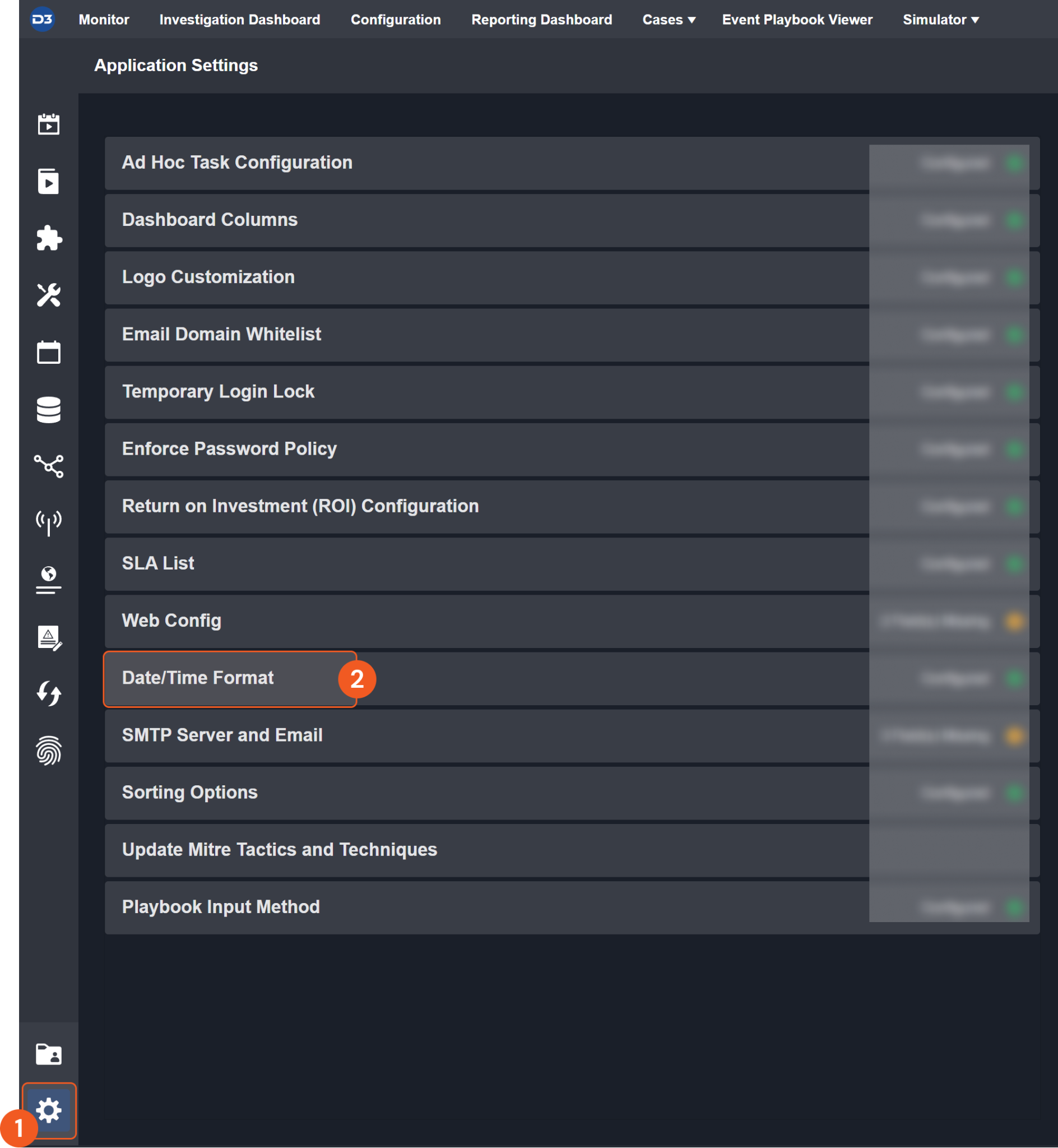
Choose your desired date and time format.
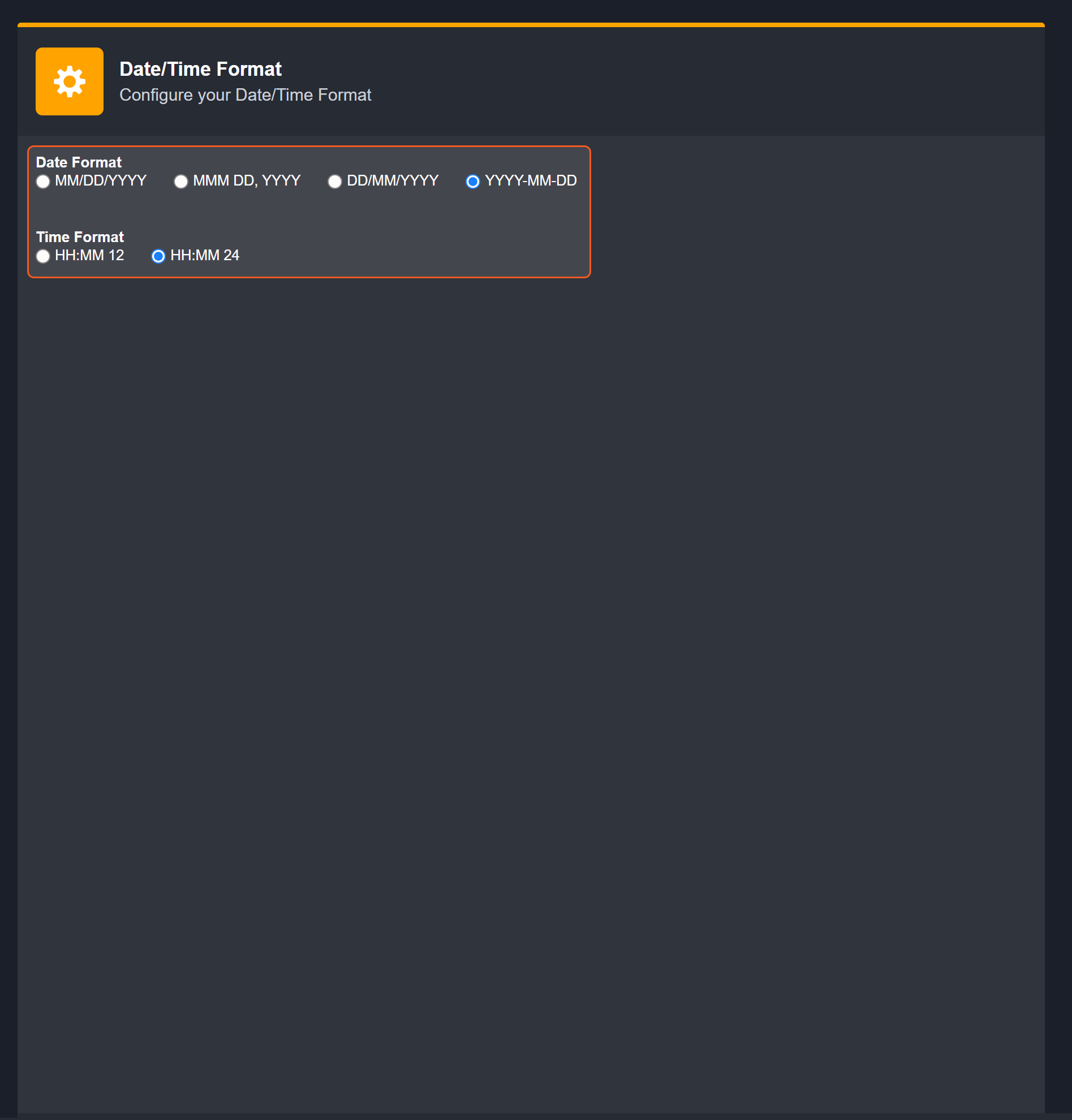
After that, you will be able to view your preferred time format when configuring the DateTime input parameters for commands.
Close Investigation
Sets the closed status of investigations using the provided IDs. This command will return investigations with their closed status. If an investigation already has the closed status, no modifications will be made, but the investigation will still be returned.
Reader Note
The parameter Investigation IDs is required to run this command.
Run the List Investigation command to obtain Investigation IDs. Investigation IDs can be found from the returned raw data at the path $[*].id.
Input
Input Parameter | Required/Optional | Description | Example |
Investigation IDs | Required | The IDs of the investigations to close. Investigation IDs can be obtained using the List Investigation command. | ["*****-*****-******-*****-******"] |
Output
Error Handling
If the Return Data is Partially Successful or Failed, an Error tab will appear in the Test Result window.
The error tab contains the details responded from D3 SOAR or third-party API calls, including Failure Indicator, Status Code, and Message. This can help you locate the root cause of a command failure.
Parts in Error | Description | Example |
Failure Indicator | Indicates the command failure that happened at a specific input and/or API call. | Close Investigation failed. |
Status Code | The response code issued by the third-party API server or the D3 SOAR system that can be used to locate the corresponding error category. For example, if the returned status code is 401, the selected connection is unauthorized to run the command. The user or system support would need to check the permission setting in the Rapid7 InsightIDR portal. Refer to the HTTP Status Code Registry for details. | Status Code: 404. |
Message | The raw data or captured key error message from the integration API server about the API request failure. | Message: Investigation IDs Not Found. |
Error Sample Data Close Investigation failed. Status Code: 404. Message: Investigation IDs Not Found. |
Fetch Event
Retrieves events from Rapid7 InsightIDR based on the given conditions.
Input
Input Parameter | Required/Optional | Description | Example |
Start Time | Required | The start time of the time range to fetch events, in UTC time. | 2020-07-27 00:00 |
End Time | Required | The end time of the time range to fetch events, in UTC time. | 2020-07-28 00:00 |
Number of Event(s) Fetched | Required | The maximum number of events to return. | 50 |
Search Condition | Required | The query statement to filter results. | logid=*****-*****-******-*****-****** |
Output
Fetch Event Field Mapping
Please note that Fetch Event commands require event field mapping. Field mapping plays a key role in the data normalization process part of the event pipeline. Field mapping converts the original data fields from the different providers to the D3 fields which are standardized by the D3 Model. Please refer to Event and Incident Intake Field Mapping for details.
If you require a custom field mapping, click + Add Field to add a custom field mapping. You may also remove built-in field mappings by clicking x. Please note that two underscore characters will automatically prefix the defined Field Name as the System Name for a custom field mapping. Additionally, if an input Field Name contains any spaces, they will automatically be replaced with underscores for the corresponding System Name.
As a system integration, the Rapid7 InsightIDR integration has some pre-configured field mappings for default field mapping.
The pre-configured field mappings are detailed below:
Field Name | Source Field |
Start Time | .timestamp |
Source username | .user |
Source IP address | .source_address |
Source port | .source_port |
Destination IP address | .destination_address |
Destination port | .destination_port |
Transport layer protocol | .transport_protocol |
Original event ID | .community_id |
Service status | .connection_status |
Bytes in | .incoming_bytes |
Bytes out | .outgoing_bytes |
Unique Event Key | .id |
Reader Note
The data format for InsightIDR's response is not the typical JSON format; instead, it follows the Regex format. As a result, the provided field mappings correspond to the response data in Regex format, not JSON.
Error Handling
If the Return Data is Failed, an Error tab will appear in the Test Result window.
The error tab contains the details responded from D3 SOAR or third-party API calls, including Failure Indicator, Status Code, and Message. This can help you locate the root cause of a command failure.
Parts in Error | Description | Example |
Failure Indicator | Indicates the command failure that happened at a specific input and/or API call. | Fetch Event failed. |
Status Code | The response code issued by the third-party API server or the D3 SOAR system that can be used to locate the corresponding error category. For example, if the returned status code is 401, the selected connection is unauthorized to run the command. The user or system support would need to check the permission setting in the Rapid7 InsightIDR portal. Refer to the HTTP Status Code Registry for details. | Status Code: 400. |
Message | The raw data or captured key error message from the integration API server about the API request failure. | Message: Invalid filter. |
Error Sample Data Fetch Event failed. Status Code: 400. Message: Invalid filter. |
Fetch Incident
Retrieves incidents from Rapid7 InsightIDR based on the given conditions.
Input
Input Parameter | Required/Optional | Description | Example |
Start Time | Required | The start time of the time range to fetch incidents, in UTC time. | 2020-07-27 00:00 |
End Time | Required | The end time of the time range to fetch incidents, in UTC time. | 2020-07-28 00:00 |
Number of Incident(s) Fetched | Required | The maximum number of incidents to return. | 50 |
Search Condition | Required | The query statement to filter results. | logid=*****-*****-******-*****-****** |
Output
Error Handling
If the Return Data is Failed, an Error tab will appear in the Test Result window.
The error tab contains the details responded from D3 SOAR or third-party API calls, including Failure Indicator, Status Code, and Message. This can help you locate the root cause of a command failure.
Parts in Error | Description | Example |
Failure Indicator | Indicates the command failure that happened at a specific input and/or API call. | Fetch Incident failed. |
Status Code | The response code issued by the third-party API server or the D3 SOAR system that can be used to locate the corresponding error category. For example, if the returned status code is 401, the selected connection is unauthorized to run the command. The user or system support would need to check the permission setting in the Rapid7 InsightIDR portal. Refer to the HTTP Status Code Registry for details. | Status Code: 400. |
Message | The raw data or captured key error message from the integration API server about the API request failure. | Message: Invalid filter. |
Error Sample Data Fetch Incident failed. Status Code: 400. Message: Invalid filter. |
List Investigation
Retrieves a page of investigations matching the given request parameters. The investigations are sorted in descending order based on their creation time.
Input
Input Parameter | Required/Optional | Description | Example |
Start Time | Required | The start time of the time range based on the investigations' creation time, to retrieve investigations. The time value is specified in UTC time. If this parameter is not defined, investigations created at any time may be returned. | 2020-05-09 00:00 |
End Time | Required | The end time of the time range based on the investigations' creation time, to retrieve investigations. The time value is specified in UTC time. If this parameter is not defined, investigations created at any time may be returned. | 2020-07-09 00:00 |
Output
Error Handling
If the Return Data is Failed, an Error tab will appear in the Test Result window.
The error tab contains the details responded from D3 SOAR or third-party API calls, including Failure Indicator, Status Code, and Message. This can help you locate the root cause of a command failure.
Parts in Error | Description | Example |
Failure Indicator | Indicates the command failure that happened at a specific input and/or API call. | List Investigation failed. |
Status Code | The response code issued by the third-party API server or the D3 SOAR system that can be used to locate the corresponding error category. For example, if the returned status code is 401, the selected connection is unauthorized to run the command. The user or system support would need to check the permission setting in the Rapid7 InsightIDR portal. Refer to the HTTP Status Code Registry for details. | Status Code: 401. |
Message | The raw data or captured key error message from the integration API server about the API request failure. | Message: Unauthorized. |
Error Sample Data List Investigation failed. Status Code: 401. Message: Unauthorized. |
Set Investigation Status
Sets the status of investigations using the provided IDs. This command will return investigations with their status reflecting the new state. If an investigation already has the specified status, no modifications will be made, but the investigation will still be returned.
Reader Note
The parameter Investigation IDs is required to run this command.
Run the List Investigation command to obtain Investigation IDs. Investigation IDs can be found from the returned raw data at the path $[*].id.
Input
Input Parameter | Required/Optional | Description | Example |
Investigation IDs | Required | The IDs of the investigations to change status. Investigation IDs can be obtained using the List Investigation command. | ["*****-*****-******-*****-******"] |
Status | Required | The updated status of the investigation (not case-sensitive) can have one of two valid values: "open" or "closed". | open |
Output
Error Handling
If the Return Data is Partially Successful or Failed, an Error tab will appear in the Test Result window.
The error tab contains the details responded from D3 SOAR or third-party API calls, including Failure Indicator, Status Code, and Message. This can help you locate the root cause of a command failure.
Parts in Error | Description | Example |
Failure Indicator | Indicates the command failure that happened at a specific input and/or API call. | Set Investigation Status failed. |
Status Code | The response code issued by the third-party API server or the D3 SOAR system that can be used to locate the corresponding error category. For example, if the returned status code is 401, the selected connection is unauthorized to run the command. The user or system support would need to check the permission setting in the Rapid7 InsightIDR portal. Refer to the HTTP Status Code Registry for details. | Status Code: 404. |
Message | The raw data or captured key error message from the integration API server about the API request failure. | Message: Investigation IDs Not Found. |
Error Sample Data Set Investigation Status failed. Status Code: 404. Message: Investigation IDs Not Found. |
